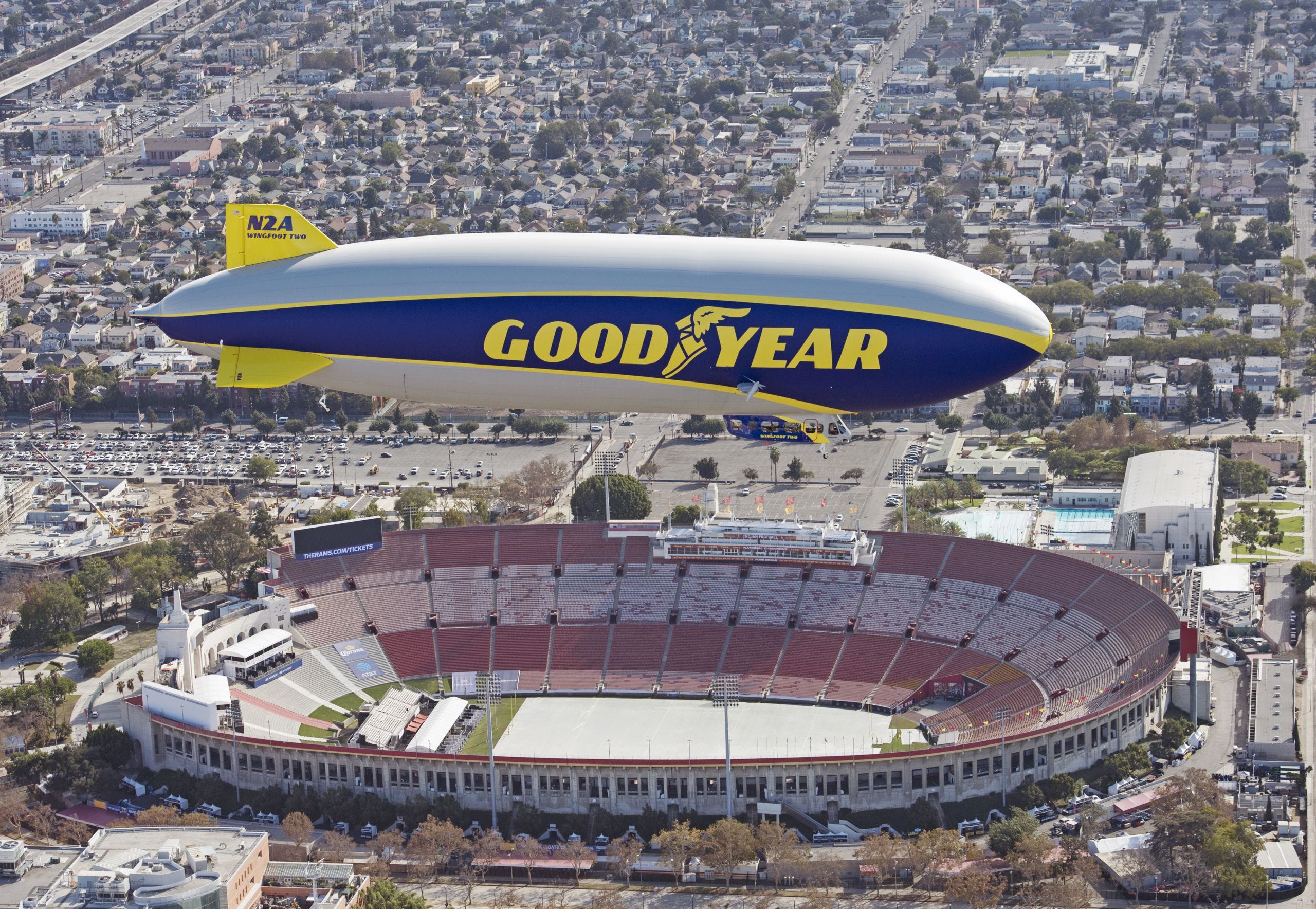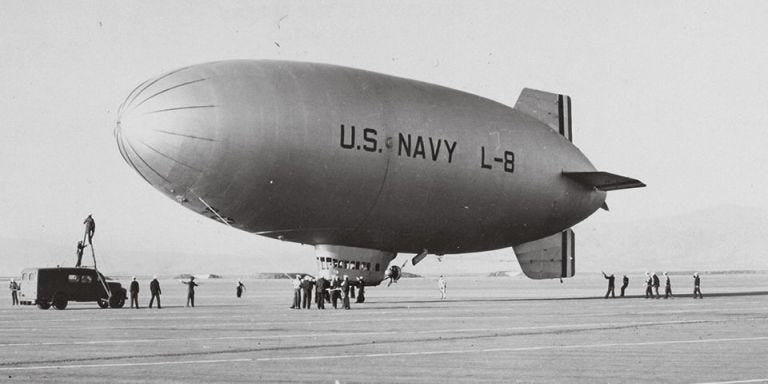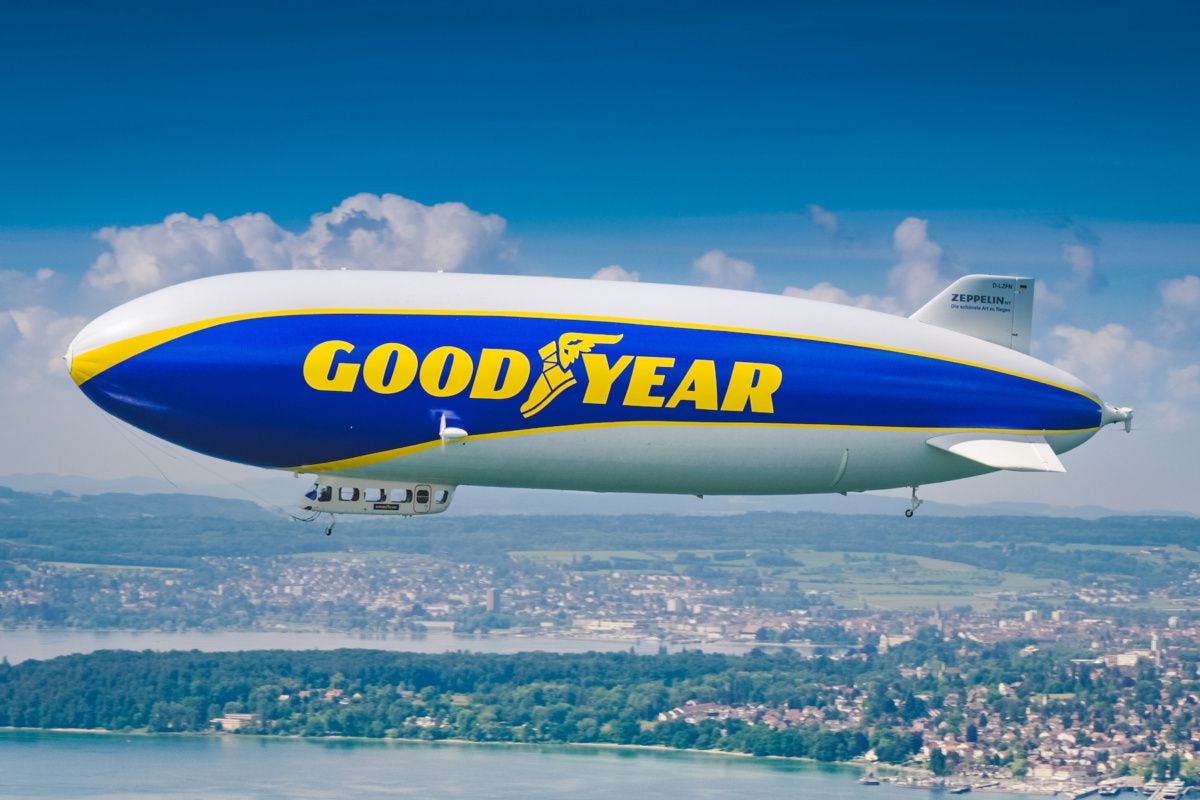The Fascinating Business Behind The Goodyear Blimp
Huddle Up is a 3x weekly newsletter that breaks down the business and money behind sports. If you are not already a subscriber, sign up and join 100,000+ others who receive it directly in their inbox each week. Today’s Newsletter Is Brought To You By Goldin!The world’s top 500 sports cards have an ROI of 855% over the last 15 years, compared to just 175% for the S&P 500 — and there is no better place to start or build your collectible portfolio than Goldin. Goldin is the leading and most trusted destination for some of the most significant pieces of sports and pop culture collectibles. Their marketplace is open 24/7, they have weekly auctions starting at just $5, and there is something for every collector. And here’s the best part: Goldin is offering No Marketplace Fees for items sold up to $10k. So vault and list your items on Goldin’s Marketplace now to enjoy this limited-time offer. I’m a big fan, and I think you will be too. Friends, Happy Friday! I hope everyone had a great week and is ready to have some fun — because today we’re talking about the business & money behind the Goodyear Blimp. The Goodyear Blimp has been to every sporting event you can imagine. I’m talking about the Olympics, Super Bowl, NBA Finals, MLB World Series, NHL Stanley Cup, Kentucky Derby, Indianapolis 500, Daytona 500, French Open, and many others. The Blimp is 75 meters long (250 feet) and weighs nearly 20,000 pounds. It holds enough helium to fill more than 1 million toy balloons, and it’s estimated to cost up to $100,000 every single trip, depending on the price of helium at the time. The Goodyear Blimp essentially invented live aerial coverage of events on television. And the details behind it are fascinating, including its origin story, the incredible logistics at each event, the upcoming extinction, and the pilots that make it all happen. The Goodyear Blimp might be the most famous Blimp on the planet, but it certainly wasn’t the first. The first non-rigid airship — these were previously known as Zeppelins but are now called Blimps — took flight in 1852, and many people thought it would be the future of passenger air travel. But then the Hindenburg disaster happened on May 6, 1937, and everything changed. The biggest Blimp ever built burst into flames trying to land in Lakehurst, New Jersey, killing 36 passengers out of nearly 100 people in total. More than 2,000 flights had carried tens of thousands of passengers more than 1 million miles on zeppelins before that. But after the tragedy, public interest in commercial blimp travel quickly faded. Still, the lighter-than-air travel technology had a lot of interest from government forces, including the United States military. And that’s where Goodyear comes in. Goodyear was founded in 1898 as a tire company. But in 1910, they launched an Aeronautics Department to build rubber-infused fabrics and coating for airplanes. The company then expanded its lighter-than-air operations from there. They manufactured hundreds of aircraft for the U.S. Navy. They added tech like record players, microphones, loudspeakers, and neon lights, and the U.S. military heavily used Goodyear’s blimps during WWII to escort (and protect) warships at sea. But it wasn’t until the 1950s that Goodyear started to make a name in sports. As television grew in popularity, Goodyear worked with NBC to provide live aerial coverage of the 1955 Tournament of Roses Parade (Rose Bowl) in Pasadena, California. NBC installed camera and microwave transmitting technology on the Goodyear Blimp. And even though it was heavy and hard to manage, it was the first aerial picture on live television, and people loved the innovative new camera angle. So when the U.S. Navy shut down its lighter-than-air craft program in the early 1960s, Goodyear shifted its focus to advertising, PR, and broadcast innovation for its blimps. From 1970 to 1979, Goodyear Blimps provided aerial coverage for more than 275 sporting events in the United States, including the Super Bowl, Indianapolis 500, Sugar Bowl, Cotton Bowl, U.S. Open (tennis), Kentucky Derby, and Daytona 500. And the technology got better, too. For example, in 1988, Goodyear rolled out the Gyrocam 360 camera and mount. This stabilized the footage and even helped save lives when a 6.9 magnitude earthquake struck during Game 3 of the 1989 World Series. But the business and logistics behind the Blimp are the most interesting part. The Goodyear Blimp has provided aerial sports broadcast coverage for nearly 70 years (1955-2023). It has covered over 2,500 sporting events, including six Olympics, 30 World Series, 26 Super Bowls, and countless college football games. And it was the first non-player or coach to be inducted into the College Football Hall of Fame. There are currently four Goodyear Blimps (Wingfoot One, Wingfoot Two, Wingfoot Three, and Europe Blimp) spread across several U.S. Airship bases (Akron, Ohio – Pompano Beach, Florida – Carson, California) to provide coverage for events. The Blimps can travel at 70 mph and fly for nearly 24 hours straight. However, each Blimp requires three pilots that rotate on 8-hour shifts, and the takeoff and landing process alone requires 20 crew members, an 18-wheel truck, and multiple other vans. But Goodyear doesn’t actually make any money on this. Well, at least not directly. Goodyear agrees to cover all expenses — equipment, travel, helium, employees, etc. — for its Blimp coverage in exchange for marketing during on-air TV broadcasts. “During a typical week, prep for the game begins on Wednesday with the television technicians departing on Thursday,” Forbes reported in 2016. “Then, on Friday, the rest of the crew leaves with the Blimp. Depending on the distance to the game, there might be two travel days, as the Blimp flies to the location and tops out somewhere between 50-73 MPG, depending on the model of the Blimp and wind conditions.” But the bad news is that the Goodyear Blimp may not be in action much longer. Drones can provide similar aerial footage for much less than $100,000 per event. And with blimp pilot training taking 250 to 400 hours (vs. 40 hours for a single-engine plane), there are now just 17 full-time blimp pilots in the United States. Thank you for reading Huddle Up. This post is public so feel free to share it. I hope everyone has a great weekend. We’ll talk on Monday. Interested in advertising with Huddle Up? Email me. Your feedback helps me improve Huddle Up. How did you like today’s post? Loved | Great | Good | Meh | Bad Extra Credit: My Appearance on What’s Next With Eric WoodEric Wood is a former NFL Pro Bowler who was gracious enough to invite me on his podcast. We chatted about my pivot from finance to sports, building a personal media company, the future of the NFL, and more. I had a lot of fun, so go check it out! Huddle Up is a 3x weekly newsletter that breaks down the business and money behind sports. If you are not already a subscriber, sign up and join 100,000+ others who receive it directly in their inbox each week.
Read Huddle Up in the app
Listen to posts, join subscriber chats, and never miss an update from Joe Pompliano.
© 2023 |




